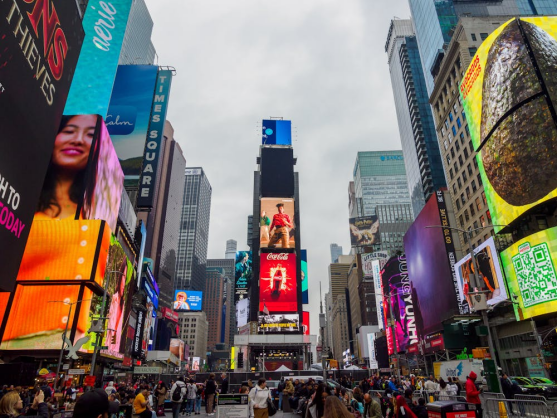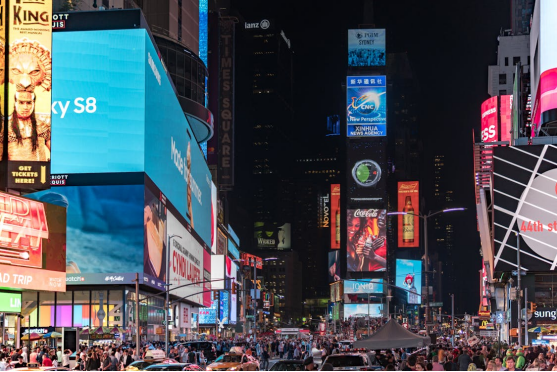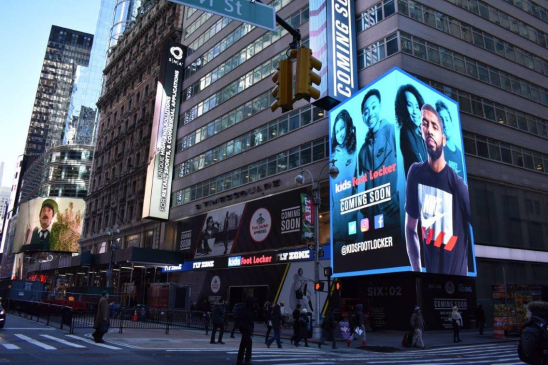Why LED Displays Are the Core of Precise Advertising in DOOH
With the rapid development of digital advertising, Digital Out-of-Home (DOOH) advertising is becoming the preferred choice for an increasing number of brands. As a key technological component of DOOH advertising, LED displays, with their high-quality display effects, flexibility, and precise targeting capabilities, are leading the transformation of the advertising industry. So, how do LED displays play a core role in DOOH advertising? Let’s explore this in detail.

DOOH Advertising: A Leap from Traditional to Digital
Traditional Out-of-Home (OOH) advertising typically uses static billboards, posters, or printed materials. Digital Out-of-Home (DOOH) advertising, on the other hand, breaks through the limitations of traditional methods by using digital screens that allow advertisers to change content in real-time and even adjust advertisements based on environmental changes. DOOH not only captures the audience’s attention but also delivers advertising content with precision through digital technology.
Digital Signage and Digital Billboards: The Two Main Forms of DOOH
DOOH advertising has two main forms: Digital Signage and Digital Billboards. Although both fall under the DOOH category, they have different application scenarios and purposes:
1. Digital Billboards
Typically used for large outdoor billboards, such as those along highways, city squares, or busy intersections. These digital billboards are usually large in size and aim to reach a wide audience, delivering brand information, promotional ads, or event announcements. The key feature of digital billboards is their ability to display large-scale visual content to capture the attention of distant viewers.
2. Digital Signage
This type of DOOH advertising is usually found in indoor environments or specific outdoor locations, such as shopping malls, stations, airports, hotels, and restaurants. Digital signage places more emphasis on interactivity and geo-targeting, typically used to deliver more targeted and localized information, even real-time interactive content. These displays are suitable for conveying information to specific groups, such as promotions, directions, or store information.
Why LED Displays Are the Key Technology in DOOH Advertising
LED displays are a core component of DOOH advertising. Compared to traditional billboards, LED displays are capable of showcasing high-definition, high-brightness, and high-contrast dynamic content, adapting to different environments and weather conditions. Whether it’s a street advertisement under strong sunlight or an interactive display in an indoor mall, LED screens can clearly present content.
Another advantage of LED displays is their ultra-wide viewing angles. Unlike traditional flat advertisements, LED screens provide a broader viewing range, ensuring that the ad content is visible to audiences from multiple angles, whether in busy urban areas or at crowded intersections.

Technical Requirements for LED Displays in DOOH Advertising
To maximize the effectiveness of DOOH advertising, LED displays must meet the following technical requirements:
1. High Brightness
DOOH ads are usually displayed outdoors, so the screen must have sufficient brightness to ensure visibility even under direct sunlight. Typically, LED displays need to have a brightness of at least 2000-3000 nits to remain clear during the day.
2. High Resolution
DOOH content needs to be of high clarity to ensure the details and visual effects of the advertisement are clear. LED displays must have a high enough resolution to present fine images and text, ensuring accurate brand message delivery.
3. Durability and Protection Rating
Since LED displays are typically used outdoors, they must have excellent weather resistance and protective features. Waterproof, dustproof, and windproof designs are essential to ensure the screen continues to operate properly even under adverse weather conditions.
4. Wide Viewing Angle
To ensure the ad reaches a broader audience, LED displays need to offer a wide viewing angle. This is particularly important in busy traffic intersections or large shopping centers, where a broad angle ensures that more people can see the ad, no matter from what direction they approach.
5. Smart Content Management and Adjustment
The content of DOOH ads needs to be dynamically adjusted based on real-time data (e.g., time, weather, audience behavior). LED displays should support intelligent content management systems that can automatically adjust the displayed content according to different scenarios, locations, and times, ensuring the content is always relevant and timely.
6. Interactivity
With the rise of interactive advertising, LED displays must also support interactive capabilities. This can include touch-screen interaction, QR code scanning, and even integration with social media, making the ad content more engaging for the audience. For instance, viewers can scan QR codes to get more information, participate in activities, or interact with the advertisement in real time.

The Greatest Advantage: Making Ads More Targeted
One of the biggest advantages of DOOH is the precision of ad targeting. By combining data analysis and location-based technologies, LED displays can dynamically adjust ad content based on specific locations, times, real-time weather, or audience needs. Here are some common methods of precise ad targeting:
• Dayparting
LED displays can show different ad content based on different times of the day. For example, breakfast ads can be displayed in the morning, drink ads in the afternoon, and dinner promotions in the evening.
• Geotargeting
By integrating GPS location technology, LED displays can showcase localized ads based on a specific location. For instance, an LED display near a mall can show promotional information for that particular mall.
• POI Targeting (Point of Interest)
LED displays can display relevant ads based on the consumer’s location. For example, LED screens near a major sports event can display ads related to the event, making the advertising more relevant.
Interactivity and Flexibility: Enhancing Ad Appeal
The interactivity of LED displays is also a key advantage in DOOH advertising. Modern LED displays not only showcase static ads but also allow for touch, QR scanning, and other forms of interaction with the audience. This interaction enables advertisers to collect real-time feedback from viewers, and use that data to optimize ad content. Additionally, the flexibility of LED displays allows advertisers to make real-time adjustments to content, better adapting to different environments and audience needs.
LED displays, as a core technology in DOOH advertising, provide high brightness, high resolution, durability, and interactivity, making them indispensable tools in modern advertising. They not only enhance the visual impact of advertisements but also significantly increase the relevance and engagement of ads through precise targeting, smart content management, and interactivity. With continuous technological advancements, LED displays will play an increasingly important role in DOOH advertising, helping brands achieve more effective and targeted communication.